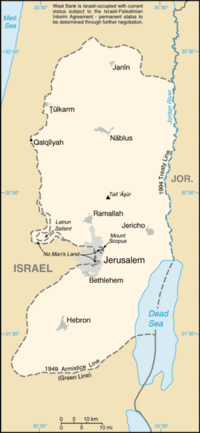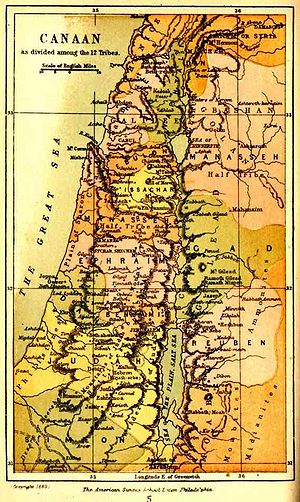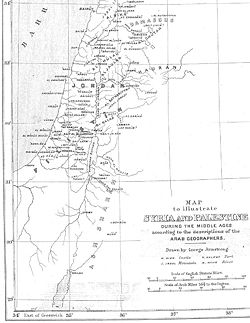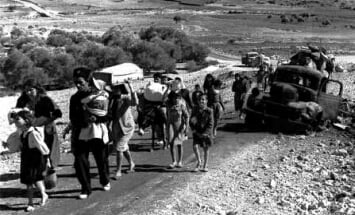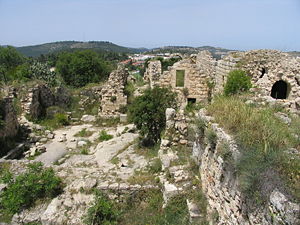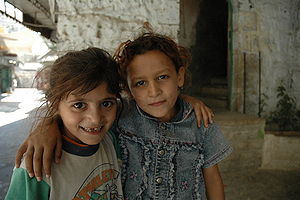Difference between revisions of "West Bank" - New World Encyclopedia
Mike Butler (talk | contribs) m |
Mike Butler (talk | contribs) |
||
| Line 104: | Line 104: | ||
===Structure=== | ===Structure=== | ||
| − | The | + | [[Image:Nakba50.jpg|thumb|right|250px|Cairo 1998: Yasser Arafat attends the Arab League meeting to commemorate the 50th anniversary of Al-Nakba.]] |
| + | The '''President of the Palestinian National Authority''' is the highest-ranking political position (equivalent to [[head of state]]) in the [[Palestinian National Authority]] (PNA). | ||
The president is elected by popular elections. | The president is elected by popular elections. | ||
| Line 114: | Line 115: | ||
===Status=== | ===Status=== | ||
| + | [[Image:Palestinian refugees.jpg|right|400px|thumb|Palestinian refugees in 1948.]] | ||
Jordan governed the West Bank from 1950 until it was occupied by Israel in the Six-Day War of 1967. During the 1967 war, Israel occupied the West Bank and established a military administration through the area, excluding East Jerusalem, to which Israel extended Israeli citizenship, law, and civil administration. For 10 years there was little resistance resistance to Israeli rule, during which time Israel increased electrification and improved housing and health care in the area. | Jordan governed the West Bank from 1950 until it was occupied by Israel in the Six-Day War of 1967. During the 1967 war, Israel occupied the West Bank and established a military administration through the area, excluding East Jerusalem, to which Israel extended Israeli citizenship, law, and civil administration. For 10 years there was little resistance resistance to Israeli rule, during which time Israel increased electrification and improved housing and health care in the area. | ||
| Line 137: | Line 139: | ||
===Annexation=== | ===Annexation=== | ||
| + | [[Image:SubaRuins.jpg|thumb|right|300px|Ruins of the Palestinian village of [[Suba (Village near Jerusalem)|Suba]], near Jerusalem, overlooking Kibbutz Zova, which was built on the village lands.]] | ||
Israel annexed the territory of [[East Jerusalem]], and its Palestinian residents (if they should decline Israeli citizenship) have legal [[permanent residency]] status. Although permanent residents are permitted, if they wish, to receive Israeli citizenship if they meet certain conditions including swearing allegiance to the State and renouncing any other citizenship, most Palestinians did not apply for Israeli citizenship for political reasons. | Israel annexed the territory of [[East Jerusalem]], and its Palestinian residents (if they should decline Israeli citizenship) have legal [[permanent residency]] status. Although permanent residents are permitted, if they wish, to receive Israeli citizenship if they meet certain conditions including swearing allegiance to the State and renouncing any other citizenship, most Palestinians did not apply for Israeli citizenship for political reasons. | ||
| Line 156: | Line 159: | ||
===West Bank barrier=== | ===West Bank barrier=== | ||
| − | [[Image:TelAvivPan_Peduel.JPG|right|thumb| | + | [[Image:TelAvivPan_Peduel.JPG|right|thumb|500px|Panoramic view toward Tel Aviv from the Settlement [[Peduel]] in the west bank, the [[Green line]] passes less than 20km from central [[Tel Aviv]]]] |
The barrier is a very controversial project. Supporters claim the barrier is a necessary tool protecting Israeli civilians from Palestinian terrorism, including suicide bombing attacks, that increased significantly during the [[al-Aqsa Intifada]]; its supporters claim that the onus is now on the Palestinian Authority to fight terrorism. | The barrier is a very controversial project. Supporters claim the barrier is a necessary tool protecting Israeli civilians from Palestinian terrorism, including suicide bombing attacks, that increased significantly during the [[al-Aqsa Intifada]]; its supporters claim that the onus is now on the Palestinian Authority to fight terrorism. | ||
| Line 165: | Line 168: | ||
==Economy== | ==Economy== | ||
| − | The West Bank, the larger of the two areas under the Palestinian | + | [[Image:Jericho_checkpoint_2005.jpg|thumb|350px|Checkpoint before entering Jericho, 2005.]] |
| + | The West Bank, the larger of the two areas under the Palestinian Authority, has undergone a sharp decline in economic conditions since the second intifadah began in September 2000. The increased violence and Israeli checkpoint closures associated with the conflict caused a recession in 2001-02. The World Bank compared this recession to the [[Great Depression]] of 1929. In 2006, [[Hamas]] won legislative control of the [[Palestinian Authority]], triggering a halt in international aid from countries labelling it a terrorist organization, including the [[United States]], members of the [[European Union]], and [[Israel]]. | ||
| − | + | As of December 2006, unemployment in the West Bank and the Gaza Strip has risen from 23 percent in 2005 to over 50 percent. Two-thirds of Palestinians are living below the poverty line. In the last four months of 2006, approximately 10,000 have emigrated from the territories, and approximately 50,000 have applied to do so. For the last nine months of that year, the 160,000 civil service workers, who were the primary breadwinners for a third of households, have not received their full salaries due to the cuts in foreign aid | |
| − | + | The West Bank has 2800 miles (4500km) of roads, of which 1680 miles (2700km) are paved. In response to shootings by Palestinians, some highways, especially those leading to [[Israeli settlements]], are completely inaccessible to cars with Palestinian license plates, while many other roads are restricted only to public transportation and to Palestinians who have special permits from Israeli authorities. Israel maintains more than 50 checkpoints in the West Bank | |
| − | + | The West Bank has three paved airports which are currently for military use only. The only civilian airport of [[Atarot Airport]] in northern Jerusalem, which was open only to Israeli citizens was closed in 2001 due to the Intifada. | |
| − | Per capita GDP in 2005 | + | The Israeli [[Bezeq]] and Palestinian [[PalTel]] telecommunication companies provide communication services in the West Bank. The [[Palestinian Broadcasting Corporation]] broadcasts from an AM station in Ramallah.. Most Palestinian households have a radio and TV, and satellite dishes for receiving international coverage are widespread. PalTel has begun implementing an initiative to provide ADSL broadband internet service to all households and businesses. |
| + | |||
| + | Exports (including Gaza Strip) totalled $301-million in 2005. Export commodities included olives, fruit, vegetables, and limestone. Export partners included Israel, Jordan, and Gaza Strip. | ||
| + | |||
| + | Imports totalled $2.44-billion. Import commodities included food, consumer goods, construction materials. Import partners included Israel, Jordan, and Gaza Strip. Per capita GDP in 2005 (including Gaza Strip) was $1500. | ||
==Demographics== | ==Demographics== | ||
| Line 223: | Line 231: | ||
Since the publication of the study, the Palestine Central Bureau of Statistics has revised its population estimates down by 750,000 as a result of immigration exaggerations.<ref>http://www.azure.org.il/magazine/magazine.asp?id=308</ref> | Since the publication of the study, the Palestine Central Bureau of Statistics has revised its population estimates down by 750,000 as a result of immigration exaggerations.<ref>http://www.azure.org.il/magazine/magazine.asp?id=308</ref> | ||
| − | |||
| − | |||
| − | |||
| − | |||
| − | |||
| − | |||
| − | |||
| − | |||
| − | |||
| − | |||
| − | |||
| − | |||
| − | |||
| − | |||
| − | |||
| − | |||
| − | |||
| − | |||
| − | |||
| − | |||
| − | |||
| − | |||
| − | |||
== Higher education == | == Higher education == | ||
Revision as of 21:48, 15 May 2007
The West Bank (Arabic: الضفة الغربية, aḍ-Ḍiffä l-Ġarbīyä, Hebrew: הגדה המערבית, Hagadah Hamaaravit), also known as Judea and Samaria, is a landlocked territory on the west bank of the Jordan River in the Middle East.
The territory was the homeland to Palestinians until the 1948 war of independence . . . .
This name carries an emotional meaning to many Jews as the cradle of Jewish Nation is derived from the time of King David in the region, the main religious sites and tombs are present there, and continuous Jewish communities were concentrated in the area throughout the years.
In 2007, Palestinians rescribed it as an Israeli-occupied territory, while Israelis described it as a disputed territory . . . .
Etymology
The name "West Bank" was apparently first used by Jordanians at the time of their annexation of the region, has become the most common name used in English, and describes territory on the west bank of the river Jordan — the Kingdom of Jordan being on the east bank of the same river.
Israelis refer to the region either as "The West Bank or as Judea (Hebrew: "Yehuda" "יהודה") and Samaria (Hebrew: "Shomron" "שומרון"), after the two biblical kingdoms (the southern Kingdom of Judah and the northern Kingdom of Israel — the capital of which was, for a time, in the town of Samaria). The border between Judea and Samaria is a belt of territory immediately north of (and historically traditionally including) Jerusalem sometimes called the "land of Benjamin". The name Judea and Samaria has been in continual use by Jews as well as various others since biblical times.
Geography
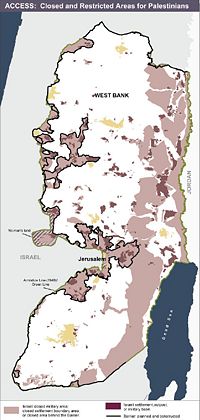
Bordering Jordan to the east and Israel in all other directions, the West Bank is a landlocked territory that has a total area of 5860 square kilometres, being 5640 sq km of land and 220 sq km of water – slightly smaller than the U.S. state of Delaware.
The terrain is mostly rugged dissected upland, some vegetation in west, but barren in east. It is mostly composed of north-south–oriented limestone hills, called called the Samarian Hills north of Jerusalem and the hills of Judea to the south, with a height of 2300 to 3000 feet (700 to 900 meters). The hills descend to the east to the low-lying Jordan rift valley and the Dead Sea.
Elevation ranges from the lowest point, which is the Dead Sea, at 408 meters below sea level, and the highest point, Tall Asur, at 1022 meters above sea level. The highlands are the main recharge area for Israel's coastal aquifers.
The climate is temperate; temperature varies with altitude, with warm to hot summers, cool to mild winters. Annual rainfall of more than 27 inches (685 mm) occurs in the highest areas in the northwest and declines in the southwest and southeast, along the Dead Sea, to less than four inches (100mm).
Non-irrigated hill regions, especially in Samaria, are used to graze sheep and to cultivate cereals, olives, and fruits such as melons. Irrigated land in the hills and the Jordan River valley is intensively cultivated for assorted fruits and vegetables.
Droughts are a natural hazard. A current environmental issue concerns adequate of fresh water supply, and sewage treatment.
The most densely populated part of the region is a mountainous spine, running north-south, where the cities of Nablus, Ariel, Ramallah, Al-Bireh, Ma'ale Adummim, Bethlehem, Beitar Illit, Gush Etzion, and Hebron] are located. Jenin, in the extreme north of the West Bank is on the southern edge of the Jezreel Valley. Modi'in Illit, Qalqilyah and Tulkarm are in the low foothills adjacent to the Israeli coastal plain, and Jericho is situated near the Jordan River, just north of the Dead Sea.
The main religious sites and tombs of Judaism are located on the. West Bank. These include Rachel's Tomb at Bethlehem, the Cave of the Patriarchs that is said to be the burial place of Abraham, Sarah, Rebekah, Isaac (Ishaq), Jacob and Leah at Hebron, and Jericho, mentioned in the Biblical Book of Joshua as the first location that the Israelites conquered. Nablus has Joseph's Tomb, Jacob's Well, the site of Dinah's rape, location of the Middle Bronze Gate, where the Israelites rejected Rehoboam and also the location of the destroyed Samaritan temple. Ramallah, an economic centre and the location of the Palestinian National Authority's West Bank administration, is located close to the biblical Bethel, the location where Jacob had his divine revelation dream in Genesis, and the location where the Israelites built a temple. Beitar Illit (Betar) is identified with the second century Bar Kochba revolt's Jewish stronghold of Betar.
The West Bank has sites of importance to the Christian religion. Bethlehem is believed to be the birthplace of Jesus of Nazareth, in a location currently occupied by the Church of the Nativity, and is home to one of largest Christian communities in the Middle East. The Church of the Nativity, built by Constantine the Great in 330, perhaps the oldest existing Christian church in the world, stands in the centre of Bethlehem over a grotto or cave called the Holy Crypt, which according to Christian tradition, is the place where Jesus was born. Close to it is another grotto, where Jerome the Latin father spent 30 years translating the Scriptures into Latin. The twelfth-century Monastery of the Qurantul on the Mount of Temptation is built on a majestic site at Jericho where Jesus is believed to have fasted for 40 days while tempted by the devil.
For Muslims, Al-Bireh is where the Ayyubid warrior Saladin camped before he conquered Jerusalem. Until 1917, the city served as a political and administrative centre for the Ottoman Empire.
History
The West Bank has been the site of pre-human and human occupation for more than 200,000 years. Mousterian Neanderthals appear to be the earliest inhabitants, around 200,000 B.C.E.
Jewish tradition holds that the West Bank has been part of the Jewish Holy Land and Promised land for 4000 years, since the time of the patriarchs (Abraham, Isaac, and Jacob).
Canaan is an ancient term for a region approximating to present-day Israel and the West Bank and Gaza, plus adjoining coastal lands and parts of Lebanon and Syria. Some Canaanites are believed to have migrated there in the third millennium B.C.E. from the inner [[Arabian Peninsula.
The Philistines, a sea-faring people possibly from Crete, invaded the southern coast of Canaan, (c.1180 to 1150 B.C.E.) around the time of the arrival of the Israelites. Their territory was later named Philistia, and Gaza became one of their chief cities.
Starting around the eleventh century B.C.E., the first of a series of Jewish kingdoms and states established intermittent rule over the region that lasted more than a millennium.
Under Assyrian, Babylonian, Persian, Greek, Roman, Byzantine, and (briefly) Sassanian rule, Jewish presence in the region dwindled because of mass expulsions. In particular, the failure of the Bar Kokhba's revolt against the Roman Empire in 32 C.E. resulted in a large-scale expulsion of Jews. The Romans gave the name Syria Palaestina to the area in an attempt to erase Jewish ties to the land. Nevertheless, the Jewish presence in Palestine remained constant. The main Jewish population shifted from the Judea region to the Galilee.
The land was conquered from the Byzantine Empire in 638 C.E. during the initial Muslim conquests. The area was ruled by the Omayyads, then by the Abbasids, Crusaders, the Kharezmians and Mongols, before becoming part of the empire of the Mamluks (1260–1516) and the Ottoman Empire in 1517.
Filasteen (فلسطين) has been the name of the region since the earliest medieval Arab geographers, who had adopted it from the Greek language term Palaestina (Παλαιστινη), first used by Herodotus, itself derived ultimately from the name of the Philistines).
Whereas European colonialism and to a lesser extent Turkish nationalism in the Ottoman Empire was the main spur in forming national identities and borders elsewhere, the main force in reaction to which Palestinian nationalism developed was Zionism, a movement that started towards the end of the nineteenth century which promoted the establishment of a national Jewish state.
After the dissolution of the Ottoman Empire in 1922, this territory became part of the British Mandate of Palestine. The 2007 border of the West Bank was not a dividing line of any sort during the mandate period.
When the United Nations General Assembly voted in 1947 to partition Palestine into a Jewish State, an Arab State, and an internationally-administered enclave of Jerusalem, almost all of the West Bank was assigned to the Arab State. In the ensuing 1948 Arab-Israel war, the neighboring kingdom of Jordan captured the territory, and annexed it in 1950, an annexation recognized only by the United Kingdom. The area was under Jordanian rule until 1967.
The 1949 Armistice Agreements established the "Green Line" separating the territories held by Israel and its neighbors. During the 1950s, there was a significant influx of Palestinian refugees and violence together with Israeli reprisal raids across the Green Line.
In the Six-Day War of 1967, Israel captured territory including the West Bank, and in November, 1967, UN Security Council Resolution 242 was unanimously adopted, calling for "the establishment of a just and lasting peace in the Middle East" to be achieved by "the application of both the following principles:" "Withdrawal of Israeli armed forces from territories occupied in the recent conflict" and: "Termination of all claims or states of belligerency" and respect for the right of every state in the area to live in peace within secure and recognised boundaries. Egypt, Jordan, Israel and Lebanon entered into consultations with the UN Special representative over the implementation of 242.
The Israel-Egypt Peace Treaty of March, 1979, Included an agreement to lend autonomy to Palestinians across the Green Line.
A Palestinian uprising called the Intifadah began in 1987. Palestinians threw rocks at Israeli soldiers occupying the Gaza Strip and the West Bank. Israelis retaliated, and the violence escalated, resulting in hundreds of deaths.
In 1988, Jordan ceded its claims to the West Bank to the Palestine Liberation Organization, as "the sole legitimate representative of the Palestinian people."
During the 1991 Gulf War, Iraq hit Israel with 39 Scud missiles. During the war, Israel also provided gas masks for the Palestinians in the West Bank and Gaza. The PLO, however, supported Saddam Hussein. Palestinians in the West Bank and Gaza marched and famously stood on their rooftops while Scud missiles were falling and cheered Hussein, calling for him to bomb Israel with chemical weapons. Palestinians also used the gas masks against Israeli tear gas in the coming years.
The 1993 Oslo Accords declared the final status of the West Bank to be subject to a forthcoming settlement between Israel and the Palestinian leadership. Following these interim accords, Israel withdrew its military rule from some parts of West Bank, which was then split into:
- Palestinian-controlled, Palestinian-administered land (Area A)
- Israeli-controlled, but Palestinian-administered land (Area B)
- Israeli-controlled, Israeli-administered land (Area C)
Areas B and C constitute the majority of the territory, comprising the rural areas and the Jordan River valley region, while urban areas – where the majority of the Palestinian population resides – are mostly designated Area A.
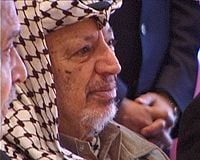
The signing of the Oslo II agreement in 1995 by Palestine Liberation Organisation leader Yasir Arafat and Israel’s prime minister Yitzak Rabin further divided the West Bank into three non-contiguous administrative categories, areas A, B and C, and 11 governorates (districts). Israel continued to maintain overall control over Israeli settlements, roads, water, airspace, "external" security and borders for the entire territory.
On November 4, 1995, a Jewish nationalist militant named Yigal Amir assassinated Rabin. Likud’s Benjamin Netanyahu, elected prime minister in 1996, withdrew from Hebron and signed the Wye River Memorandum, giving wider control to the Palestinian National Authority.
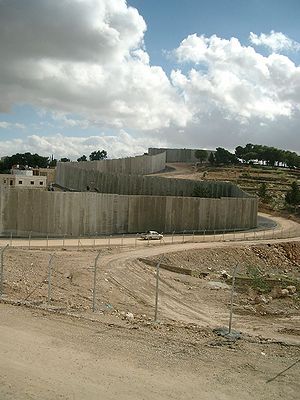
Israel’s prime minister Ehud Barak and Palestine Liberation Organisation leader Yasser Arafat conducted negotiations with U.S. President Bill Clinton at the July 2000 Camp David summit. Barak offered to form a Palestinian State initially on 73 percent of the West Bank and 100 percent of the Gaza Strip. In 10 to 25 years, the West Bank area would expand to 90 percent (94 percent excluding greater Jerusalem). Arafat rejected this deal.
After the collapse of the talks, Palestinians began a second uprising, known as the Al-Aqsa Intifadah, just after the leader of the opposition Ariel Sharon visited the Temple Mount in Jerusalem.
In 2003, the Israeli government began building the West Bank barrier, a network of fences with vehicle-barrier trenches surrounded by an on average 60 meters wide exclusion area (90 percent) and up to eight-meter high concrete walls (10 percent).
It is located mainly within the West Bank, partly along the 1949 Armistice line, or Green Line between the West Bank and Israel. As of April 2006 the length of the barrier as approved by the Israeli government was 436 miles (703km) long. Approximately 58.4 percent had been constructed, 8.96 percent was under construction, and construction had not begun on 33 percent of the barrier.
Government and politics
The Oslo Accords signed in 1993 by Israel and the PLO, established the Palestinian National Authority in 1994, a governing body for the West Bank and the Gaza Strip as a five-year transitional body during which final status negotiations between the two parties were to take place.
The Palestinian Authority is distinct from the Palestine Liberation Organization, and it is the PLO, not the PNA, which enjoys international recognition as the organization representing the Palestinian people. The Palestinian people living outside the West Bank and Gaza, which constitutes the majority of the Palestinian people, are not allowed to vote in elections for PNA offices. Under the name "Palestine", it has an observer status in the United Nations (UN) since 1974. After the 1988 Palestinian Declaration of Independence, the PLO's representation at the United Nations was renamed Palestine. It is the PLO, not the PNA, which has participated in General Assembly debates, without voting, since 1998, and which was recognized by Israel as the sole legitimate representative of the Palestinian People in the negotiations leading to the Oslo Accords.
The PNA previously received considerable financial assistance from the European Union and the United States (approximately USD $1,000,000,000 combined in 2005), but both suspended all direct aid on April 7, 2006 (as threatened in January 2006 and following Canada's March 29, 2006, decision to cut all aid) as a result of the Hamas victory in parliamentary elections.
Structure
The President of the Palestinian National Authority is the highest-ranking political position (equivalent to head of state) in the Palestinian National Authority (PNA). The president is elected by popular elections.
The prime minister is appointed by the President of the Palestinian National Authority and thus not directly elected by the Palestinian Legislative Council (parliament) or Palestinian voters. Unlike the prime minister's office in many other nations, the Palestinian Prime Minister does not serve as a member of the legislature while in office. Instead, the appointment is made independently by the ruling party. The prime minister is expected to represent the majority party or ruling coalition in the parliament.
Palestine's national legislature is called the Palestinian legislative council (Majlis al-Tashri'i in Arabic). The legislative council passed a new law in June 2005 increasing the number of MPs from 88 to 132, stipulating that half be elected under a system of proportional representation and half by traditional constituencies. New parliamentary polls took place on January 25, 2006. Initial exit polling indicated that Fatah won the most seats, though without a majority, but the results were different. Militant Islamic party Hamas took 74 of the 132 seats.
The constitution calls for an independent judiciary branch, and for the establishment of a Supreme Judicial Council.
Status
Jordan governed the West Bank from 1950 until it was occupied by Israel in the Six-Day War of 1967. During the 1967 war, Israel occupied the West Bank and established a military administration through the area, excluding East Jerusalem, to which Israel extended Israeli citizenship, law, and civil administration. For 10 years there was little resistance resistance to Israeli rule, during which time Israel increased electrification and improved housing and health care in the area.
Between 1979 and 1983, while Menachem Begin was prime minister, the number of Israeli settlements more than tripled, and the number of Israeli settlers increased more than fivefold. The increase was part of a defense strategy and to extend its agricultural economy. Land, businesses, and buildings were taken from the Arab inhabitants, many of whom were long gone. Israel claimed of a right to administer land in the West Bank not cultivated or privately owned, which could amount to between 30 and 70 percent of the West Bank. This claim gave rise to suspicions that Israel intended ultimately to annex the area piecemeal.
Anti-Israeli rioting broke out among the Arabs of the West Bank in December 1987 and became virtually a permanent feature of West Bank life.
Israel and the PLO agreed in September, 1993, on a plan to gradually extend self-government to the Palestinians of the West Bank (and Gaza Strip) over a five-year period prior to a final settlement of the issue of Palestinian statehood. Implementation began in May 1994 with the Israelis withdrew from the town of Jericho.
The future status of the West Bank, together with the Gaza Strip on the Mediterranean shore, has been the subject of negotiation between the Palestinians and Israelis, although the Road Map for Peace, proposed by the "Quartet on the Middle East" comprising the United States, Russia, the European Union, and the United Nations, envisions an independent Palestinian state in these territories living side by side with Israel.
The Palestinian people and the United Nations call the West Bank and Gaza Strip Israeli-occupied, and the United States generally agrees. Many Israelis and their supporters prefer the term disputed territories, claiming it comes closer to a neutral point of view. Israel argues that its presence is justified because: Israel's eastern border has never been defined, the disputed territories have not been part of any state, and according to the Camp David Accords (1978) with Egypt, the 1994 agreement with Jordan and the Oslo Accords with the PLO, the final status of the territories would be fixed only when there was a permanent agreement between Israel and the Palestinians.
Palestinian public opinion is almost unanimous in opposing Israeli military and settler presence on the West Bank as a violation of their right to statehood and sovereignty.
Israeli opinion is split into a number of views:
- Complete or partial withdrawal from the West Bank in hopes of peaceful coexistence in separate states (sometimes called the "land for peace" position); (According to a 2003 poll 76 percent of Israelis support a peace agreement based on that principle).
- Maintenance of a military presence in the West Bank to reduce Palestinian terrorism by deterrence or by armed intervention, while relinquishing some degree of political control;
- Annexation of the West Bank while considering the Palestinian population as (for instance) citizens of Jordan with Israeli residence permit as per the Elon Peace Plan;
- Annexation of the West Bank and assimilation of the Palestinian population to fully fledged Israeli citizens;
- Annexation of the West Bank.
- Transfer of the East Jerusalem Palestinian population (a 2002 poll at the height of the Al Aqsa intifada found 46 percent of Israelis favoring Palestinian transfer of Jerusalem residents.
Annexation
Israel annexed the territory of East Jerusalem, and its Palestinian residents (if they should decline Israeli citizenship) have legal permanent residency status. Although permanent residents are permitted, if they wish, to receive Israeli citizenship if they meet certain conditions including swearing allegiance to the State and renouncing any other citizenship, most Palestinians did not apply for Israeli citizenship for political reasons.
There are various possible reasons as to why the West Bank had not been annexed to Israel after its capture in 1967. The government of Israel has not formally confirmed an official reason, however, historians and analysts have established a variety of such, most of them demographic. Among the most agreed upon:
- Reluctance to award its citizenship to an overwhelming number of a potentially hostile population whose allies were sworn to the destruction of Israel
- Fear that the population of non-Zionist Arabs would outnumber the Israelis, appeal to different political interests, and vote Israel out of existence; thus failing to maintain the concept and safety of a Jewish state
- To ultimately exchange the land for peace with neighbouring states
Legality of settlements
Israeli settlements on the West Bank beyond the Green Line border are considered by some legal scholars to be illegal under international law. Other legal scholars have argued that the settlements are legal under international law, on a number of different grounds.
The Independent reported in March 2006 that immediately after the 1967 war Theodor Meron, legal counsel of Israel's Foreign Ministry advised Israeli ministers in a "top secret" memo that any policy of building settlements across occupied territories violated international law and would "contravene the explicit provisions of the Fourth Geneva Convention".
A contrasting opinion was held by Eugene Rostow, a former Dean of the Yale Law School and undersecretary of state for political affairs in the administration of U.S. President Lyndon Johnson, who wrote in 1991 that Israel has a right to have settlements in the West Bank under 1967's UN Security Council Resolution 242.
It is the policy of both Israel and the United States that the settlements do not violate international law, although the United States considers ongoing settlement activity to be "unhelpful" to the peace process. The European Union and the Arab League consider the settlements to be illegal. Israel also recognizes that some small settlements are "illegal" in the sense of being in violation of Israeli law. In 2005 the United States ambassador to Israel, Dan Kurtzer, expressed U.S. support "for the retention by Israel of major Israeli population centres [in the West Bank] as an outcome of negotiations”, reflecting President Bush's statement a year earlier that a permanent peace treaty would have to reflect "demographic realities" on the West Bank.
The UN Security Council has issued several non-binding resolutions addressing the issue of the settlements. Typical of these is UN Security Council resolution 446 which states [the] practices of Israel in establishing settlements in the Palestinian and other Arab territories occupied since 1967 have no legal validity, and it calls on Israel as the occupying Power, to abide scrupulously by the 1949 Fourth Geneva Convention.
West Bank barrier
The barrier is a very controversial project. Supporters claim the barrier is a necessary tool protecting Israeli civilians from Palestinian terrorism, including suicide bombing attacks, that increased significantly during the al-Aqsa Intifada; its supporters claim that the onus is now on the Palestinian Authority to fight terrorism.
Opponents claim the barrier is an illegal attempt to annex Palestinian land under the guise of security, and severely restricts Palestinians who live nearby, particularly their ability to travel freely within the West Bank and to access work in Israel, thereby undermining their economy.
Pro-settler opponents claim that the barrier is a sly attempt to artificially create a border that excludes the settlers, creating "facts on the ground" that justify the mass dismantlement of hundreds of settlements and displacement of over 100,000 Jews from the land they claim as their biblical homeland.
Economy
The West Bank, the larger of the two areas under the Palestinian Authority, has undergone a sharp decline in economic conditions since the second intifadah began in September 2000. The increased violence and Israeli checkpoint closures associated with the conflict caused a recession in 2001-02. The World Bank compared this recession to the Great Depression of 1929. In 2006, Hamas won legislative control of the Palestinian Authority, triggering a halt in international aid from countries labelling it a terrorist organization, including the United States, members of the European Union, and Israel.
As of December 2006, unemployment in the West Bank and the Gaza Strip has risen from 23 percent in 2005 to over 50 percent. Two-thirds of Palestinians are living below the poverty line. In the last four months of 2006, approximately 10,000 have emigrated from the territories, and approximately 50,000 have applied to do so. For the last nine months of that year, the 160,000 civil service workers, who were the primary breadwinners for a third of households, have not received their full salaries due to the cuts in foreign aid
The West Bank has 2800 miles (4500km) of roads, of which 1680 miles (2700km) are paved. In response to shootings by Palestinians, some highways, especially those leading to Israeli settlements, are completely inaccessible to cars with Palestinian license plates, while many other roads are restricted only to public transportation and to Palestinians who have special permits from Israeli authorities. Israel maintains more than 50 checkpoints in the West Bank
The West Bank has three paved airports which are currently for military use only. The only civilian airport of Atarot Airport in northern Jerusalem, which was open only to Israeli citizens was closed in 2001 due to the Intifada.
The Israeli Bezeq and Palestinian PalTel telecommunication companies provide communication services in the West Bank. The Palestinian Broadcasting Corporation broadcasts from an AM station in Ramallah.. Most Palestinian households have a radio and TV, and satellite dishes for receiving international coverage are widespread. PalTel has begun implementing an initiative to provide ADSL broadband internet service to all households and businesses.
Exports (including Gaza Strip) totalled $301-million in 2005. Export commodities included olives, fruit, vegetables, and limestone. Export partners included Israel, Jordan, and Gaza Strip.
Imports totalled $2.44-billion. Import commodities included food, consumer goods, construction materials. Import partners included Israel, Jordan, and Gaza Strip. Per capita GDP in 2005 (including Gaza Strip) was $1500.
Demographics
The Palestinian Central Bureau of Statistics estimates that approximately 2.5 million Palestinians lived in the West Bank (including Israeli-annexed East Jerusalem) at the end of 2006[1]. A study by the American-Israel Demographic Research Group[2] suggests that there are 1.4 million Palestinians in the West Bank. The CIA World Factbook also records the Palestinian population of the West Bank at 2.5 million.[3]
There are over 260,000 Israeli settlers living in the West Bank, as well as around 185,000 Israeli Jews living in Israeli-annexed East Jerusalem. There are also small ethnic groups, such as the Samaritans living in and around Nablus, numbering in the hundreds or low thousands. The Jews in the West Bank live mostly isolated in Israeli settlements with little social interaction with other Palestinians. Interactions between the two societies have generally declined following the Palestinian Intifadas, though an economic relationship often exists between adjacent Israeli settlements and Palestinian villages.[citation needed]
Approximately 30% of Palestinians living in the West Bank are refugees from villages and towns located in what became Israel during the 1948 Arab-Israeli War (see Palestinian exodus).[4][5][6]
Recent Developments
New Study "Arab Population In the West Bank and Gaza: The Million Person Gap" suggests the Palestine Central Bureau of Statistics seriously overestimated the growth of the Palestinian population and has double-counted certain populations when it made its original predictions in 1997. All further estimates were based on the 1997 predictions: 1. it double-counted the Jerusalem Arabs - thus adding 210,000 2. it assumed immigration into the territories, while there has in fact been steady migration - thus adding 310,000 3. it counted residents living abroad - thus adding 325,000 4. overestimated the birth rate
The new estimates place the Arab population of the West Bank at 1.41 Million.[7]
Since the publication of the study, the Palestine Central Bureau of Statistics has revised its population estimates down by 750,000 as a result of immigration exaggerations.[8]
Higher education
Before 1967 there were no universities in the West Bank (except for the Hebrew University in Jerusalem - see below). There were a few lesser institutions of higher education; for example, An-Najah, which started as an elementary school in 1918 and became a community college in 1963. As the Jordanian government did not allow the establishment of such universities in the West Bank, Palestinians could obtain degrees only by travelling abroad to places such as Jordan, Lebanon, or Europe.
After the region was captured by Israel in the Six-Day War, several educational institutions began offering undergraduate courses, while others opened up as entirely new universities. In total, seven Universities have been commissioned in the West Bank since 1967:
- Bethlehem University, a Roman Catholic institution partially funded by the Vatican, opened its doors in 1973 [1].
- In 1975, Birzeit College (located in the town of Bir Zeit north of Ramallah) became Birzeit University after adding third- and fourth-year college-level programs [2].
- An-Najah College in Nablus likewise became An-Najah National University in 1977 [3].
- The Hebron University was established in 1980 [4]
- Al-Quds University, whose founders had yearned to establish a university in Jerusalem since the early days of Jordanian rule, finally realized their goal in 1995 [5].
- Also in 1995, after the signing of the Oslo Accords, the Arab American University—the only private university in the West Bank—was founded in Jenin, with the purpose of providing courses according to the American system of education [6].
- In 2005, the Israeli government recommended to upgrade the College of Judea and Samaria in Ariel to become a full fledged university [7]. This move to create a university within an Israeli settlement has angered some Palestinians, although no official response was made by the Palestinian authority.
- The Hebrew University of Jerusalem, established in 1918, is one of Israel's oldest, largest, and most important institutes of higher learning and research. During the 1948 Arab-Israeli War, the leader of the Palestinian forces in Jerusalem, Abdul Kader Husseini, threatened that the Hadassah Hospital and the Hebrew University would be captured or destroyed "if the Jews continued to use them as bases for attacks".[9] Medical convoys between the Yishuv-controlled section of Jerusalem and Mount Scopus were attacked since December 1947.[10] After the Hadassah medical convoy massacre in 1948, which also included university staff, the Mount Scopus campus was cut off from the Jewish part of Jerusalem. After the War, the University was forced to relocate to a new campus in Givat Ram in western Jerusalem. After Israel captured East Jerusalem in the Six-Day War of June 1967, the University returned to its original campus in Mount Scopus.
Most universities in the West Bank have politically active student bodies, and elections of student council officers are normally along party affiliations. Although the establishment of the universities was initially allowed by the Israeli authorities, some were sporadically ordered closed by the Israeli Civil Administration during the 1970s and 1980s to prevent political activities and violence against the IDF. Some universities remained closed by military order for extended periods during years immediately preceding and following the first Palestinian Intifada, but have largely remained open since the signing of the Oslo Accords despite the advent of the Al-Aqsa Intifada in 2000.
The founding of Palestinian universities has greatly increased education levels among the population in the West Bank. According to a Birzeit University study, the percentage of Palestinians choosing local universities as opposed to foreign institutions has been steadily increasing; as of 1997, 41% of Palestinians with bachelor degrees had obtained them from Palestinian institutions [8]. According to UNESCO, Palestinians are one of the most highly educated groups in the Middle East "despite often difficult circumstances" [9]. The literacy rate among Palestinians in the West Bank (and Gaza) (89%) is third highest in the region after Israel (95%) and Jordan (90%) [10][11] [12].
Notes
- ↑ The Palestinian Central Bureau of Statistics
- ↑ Bennett Zimmerman & Roberta Seid (January 23, 2006). Arab Population in the West Bank & Gaza: The Million Person Gap. American-Israel Demographic Research Group. Retrieved 2006-09-27.
- ↑ https://www.cia.gov/cia/publications/factbook/print/we.html
- ↑ UNRWA in Figures: Figures as of 31 December 2004 (PDF). United Nations (April 2005). Retrieved 2006-09-27.
- ↑ Error on call to template:cite web: Parameters url and title must be specified. Palestinian National Authority Palestinian Central Bureau of Statistics.
- ↑ Ksenia Svetlova (December 1, 2005). Can trust be rebuilt?. The Jerusalem Post. Retrieved 2006-09-27.
- ↑ http://pademographics.com/Herzliya%20Presentation.ppt
- ↑ http://www.azure.org.il/magazine/magazine.asp?id=308
- ↑ 'Husseini Threatens Hadassah', The Palestine Post, 18 March, 1948, p. 1.
- ↑ The Palestine Post, 14 April, 1948, p. 3
ReferencesISBN links support NWE through referral fees
- Albin, Cecilia (2001). Justice and Fairness in International Negotiation. Cambridge University Press. ISBN 0-521-79725-X
- Bamberger, David (1985, 1994). A Young Person's History of Israel. Behrman House. ISBN 0-87441-393-1
- Gibney, Mark and Frankowski, Stanislaw (1999). Judicial Protection of Human Rights. Praeger/Greenwood. ISBN 0-275-96011-0
- Playfair, Emma (Ed.). (1992). International Law and the Administration of Occupied Territories. Oxford University Press. ISBN 0-19-825297-8
See also
- Economy of the West Bank
- Geography of the West Bank
- Israeli West Bank barrier
- West Bank Closures
- Palestinian exodus
- Rule of the West Bank and East Jerusalem by Jordan
- Palestine (region)
- Israeli Settlements
- Israel
External links
- West Bank from the CIA World Factbook
- Palestine Facts & Info from Palestinian Academic Society for the Study of International Affairs
- The Legal Status of Palestine Under International Law (Supports Palestinian claims), a publication by Birzeit University.
- United Nations - Question of Palestine
- Disputed Territories: Forgotten Facts about the West Bank and Gaza Strip - from the Israeli government
- The Westbank Dispute Analysis from ProCon
- Large map of West Bank (1992)
- MOVING UP: An Aliyah Journal, the new book, is an upbeat account about Aliyah and life in Israel.
- A series of geopolitical maps of the West Bank
- "American Thinker" opinion article which disputes some of the data in this article
- 1988 "Address to the Nation" by King Hussein of Jordan Ceding Jordanian Claims to the West Bank to the PLO
- Camden Abu Dis Friendship Association - establishing links between the North London Borough of Camden and the town of Abu Dis in the West Bank
Template:Cities in the West Bank
Credits
New World Encyclopedia writers and editors rewrote and completed the Wikipedia article in accordance with New World Encyclopedia standards. This article abides by terms of the Creative Commons CC-by-sa 3.0 License (CC-by-sa), which may be used and disseminated with proper attribution. Credit is due under the terms of this license that can reference both the New World Encyclopedia contributors and the selfless volunteer contributors of the Wikimedia Foundation. To cite this article click here for a list of acceptable citing formats.The history of earlier contributions by wikipedians is accessible to researchers here:
The history of this article since it was imported to New World Encyclopedia:
Note: Some restrictions may apply to use of individual images which are separately licensed.
